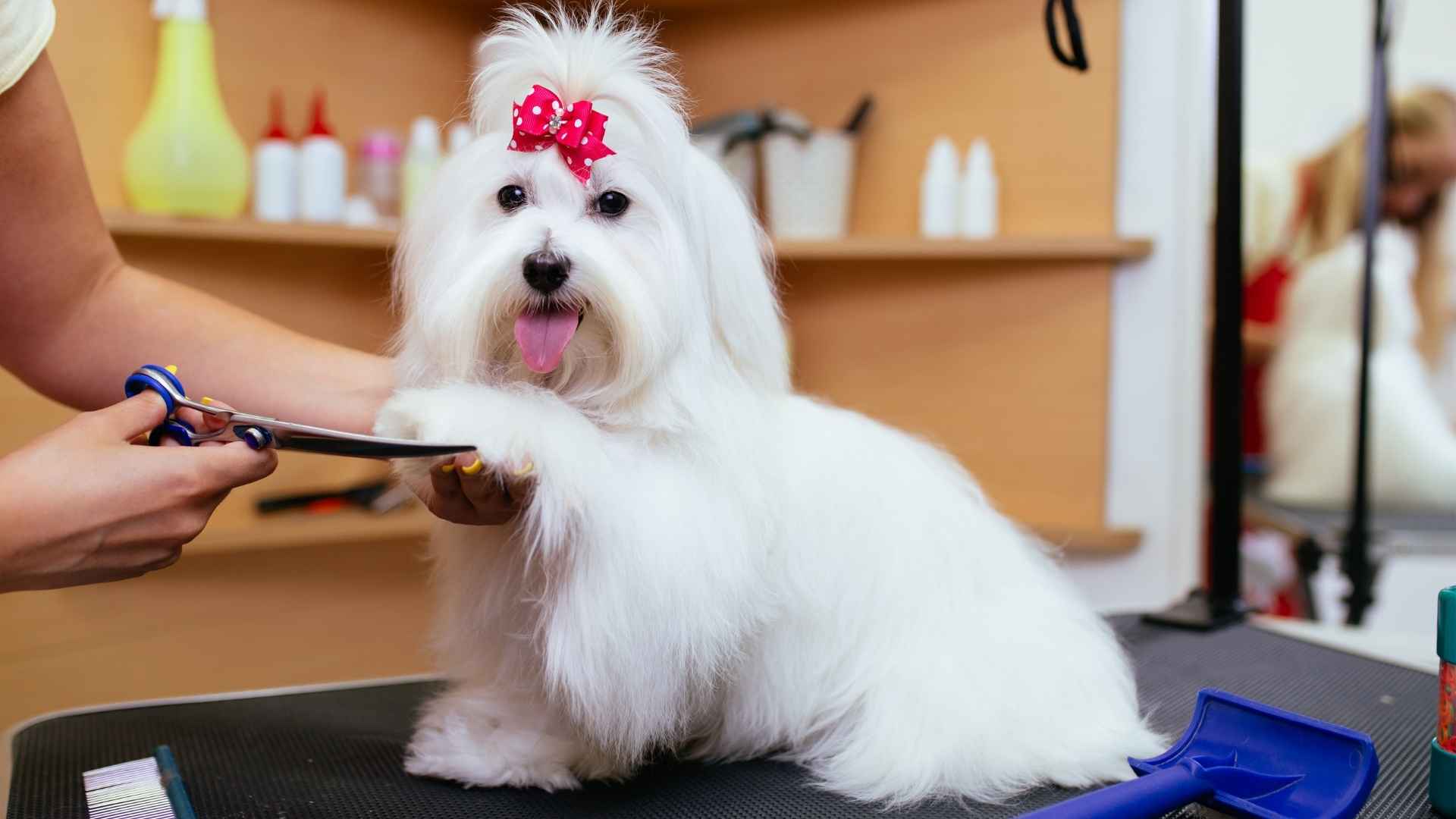When it comes to choosing a dog, one of the key considerations should be how much grooming they require. While all dogs need some level of care, certain breeds demand more frequent attention to keep their coats healthy and their skin in top condition.
If you’re a dog lover who enjoys a little extra time bonding over brushing, trimming, and pampering your furry friend, then you’re in for a rewarding experience. However, it’s important to understand that regular grooming is not just about appearances; it plays a crucial role in your dog’s overall well-being.
From preventing matting and skin infections to reducing shedding and allergies, grooming is an essential part of a dog’s health regimen. In this guide, we’ll explore the breeds that require regular grooming, offering tips and insights to help you provide the best care for your four-legged companion.
Regular Grooming Required Dog Breeds
1. Afghan Hound
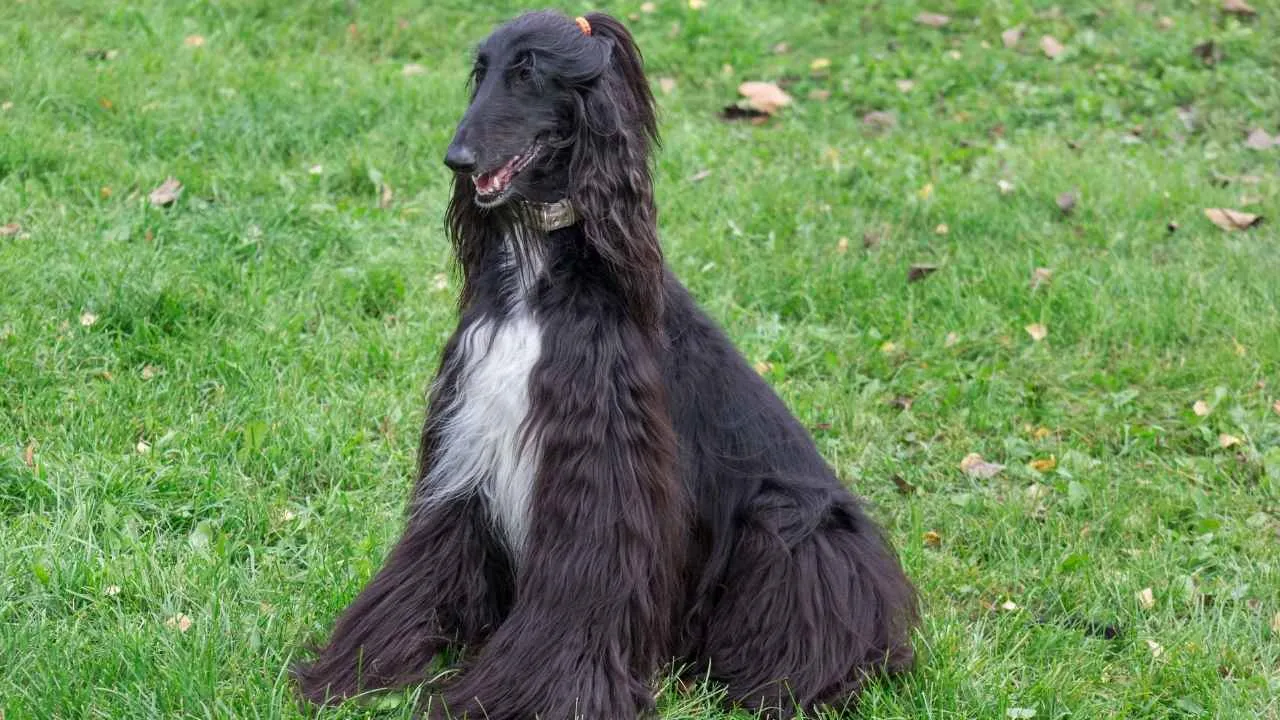
The Afghan Hound is famous for its elegant, flowing coat that demands regular upkeep to maintain its pristine condition. Its fine texture can easily become tangled or knotted, so frequent brushing is necessary to keep the fur smooth and silky.
As noted by AKC, Afghan puppies have short, fuzzy coats (including adorable facial hair called ‘monkey whiskers’) that require little maintenance. Regular bathing is also an essential part of their grooming routine.
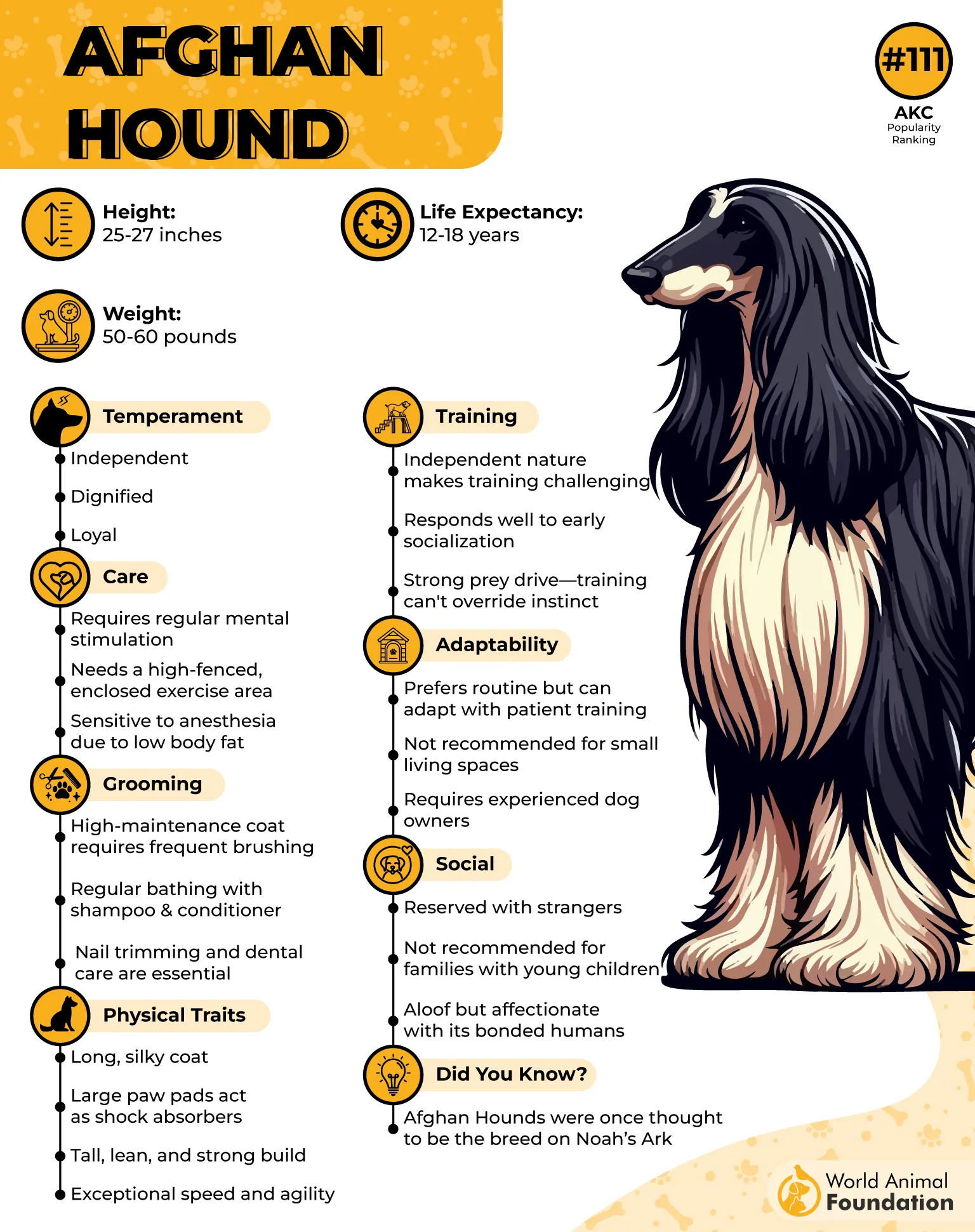
Their coat traps dirt and oils, so washing is necessary to keep them clean. Using a mild, nourishing shampoo preserves the softness and shine of their coat, and thorough drying is crucial to avoid matting.
Grooming extends beyond the coat to other areas, such as the ears, eyes, and nails. Routine ear cleaning helps prevent infections caused by moisture accumulation in their long ear hair, while trimming their nails ensures comfort and proper paw alignment.
Maintaining the Afghan Hound’s grooming schedule also supports their overall health. Brushing promotes skin circulation and encourages healthy hair growth, while regular grooming provides an opportunity to spot any skin issues or parasites early.
While caring for an Afghan Hound’s luxurious coat can be time-intensive, it’s a fulfilling task for owners who take pride in their dog’s beauty. With the right tools and consistent effort, keeping their elegant appearance intact becomes an enjoyable experience.
2. Poodle
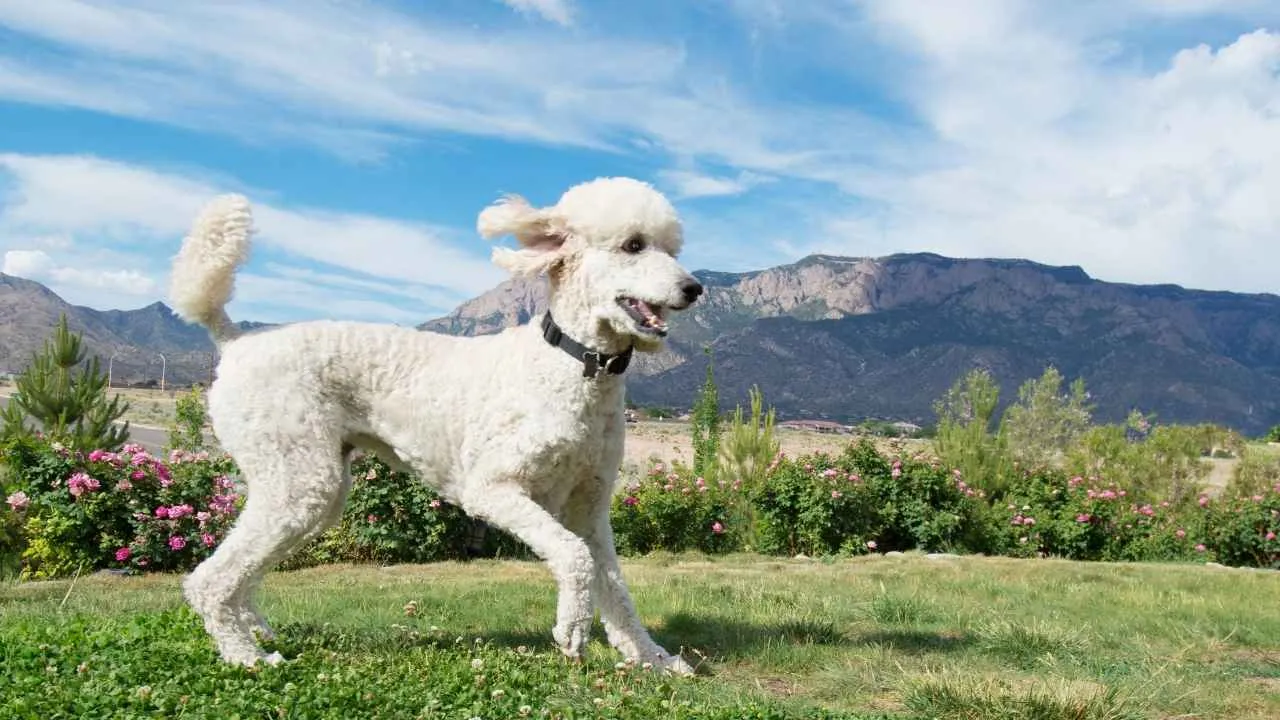
Poodles are known for their stunning curly coats, but maintaining their beauty requires a dedicated grooming routine. Their thick fur can easily mat if not properly cared for, so regular attention is essential. Whether Toy, Miniature, or Standard, grooming is key to their health and comfort.
Brushing is crucial for Poodles. Their curls tangle quickly, so daily or at least every other day brushing is necessary to prevent mats. A slicker brush works best for smoothing out their curls, helping to maintain both appearance and skin health by preventing irritation from tangles.
Poodles are a high-maintenance breed, particularly when it comes to their coats. In addition to brushing, they need regular haircuts every 4-6 weeks to keep their shape and prevent overgrowth. A well-maintained coat ensures they stay comfortable and cool, not just looking good.
For a simpler routine, opting for shorter haircuts is a good choice. Even with a shorter coat, regular trimming and brushing are essential to prevent buildup and skin irritation.
Although Poodles require significant care, the effort is worthwhile. Their beautiful coats and friendly, intelligent personalities make them fantastic companions. With groomed regularly, they remain both comfortable and striking, making them a joy to have as part of the family.
3. Bichon Frise
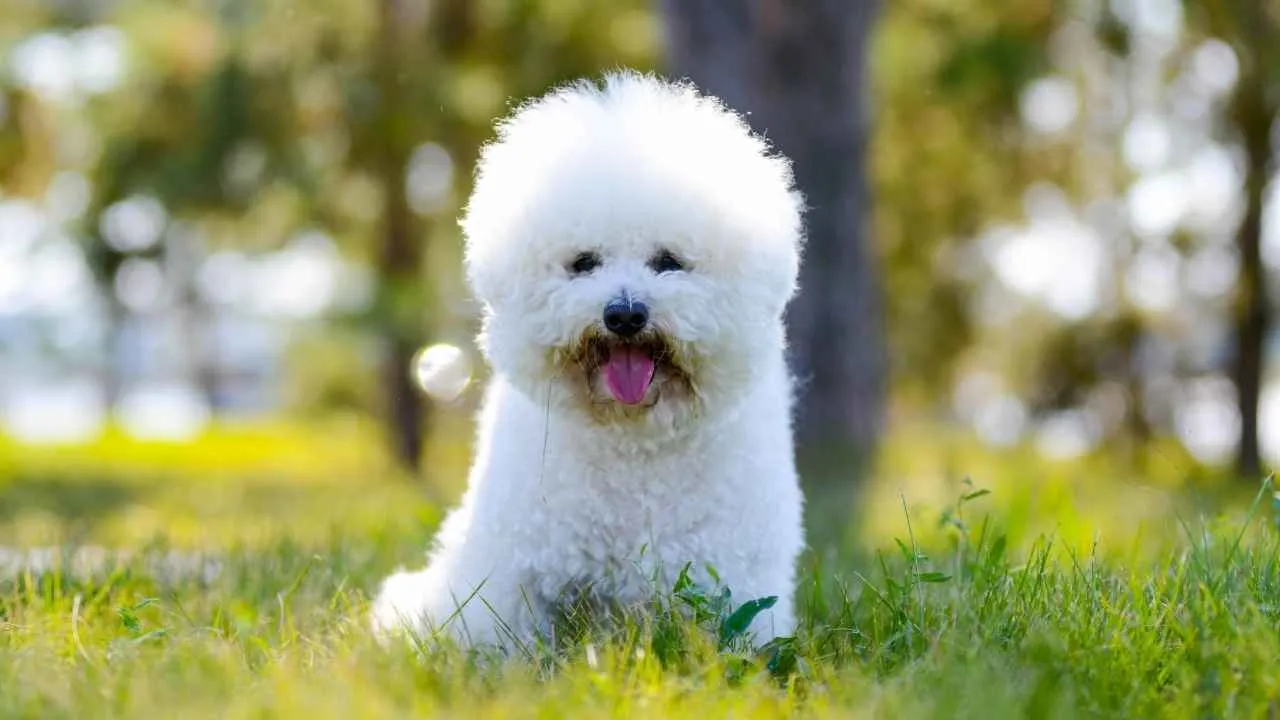
The Bichon Frise is a delightful bundle of curls, but maintaining that signature cloud-like coat takes real commitment. Beneath their soft, fluffy appearance is a dense, double-layered coat that tangles easily without consistent care. Grooming isn’t optional—it’s essential to keep their fur light, healthy, and mat-free.
Brushing a Bichon at least every other day is key to preventing knots and mats from forming close to the skin. Their hair doesn’t shed much, which makes brushing even more important to remove loose strands. A slicker brush and gentle technique help keep its coat smooth and breathable without irritating.
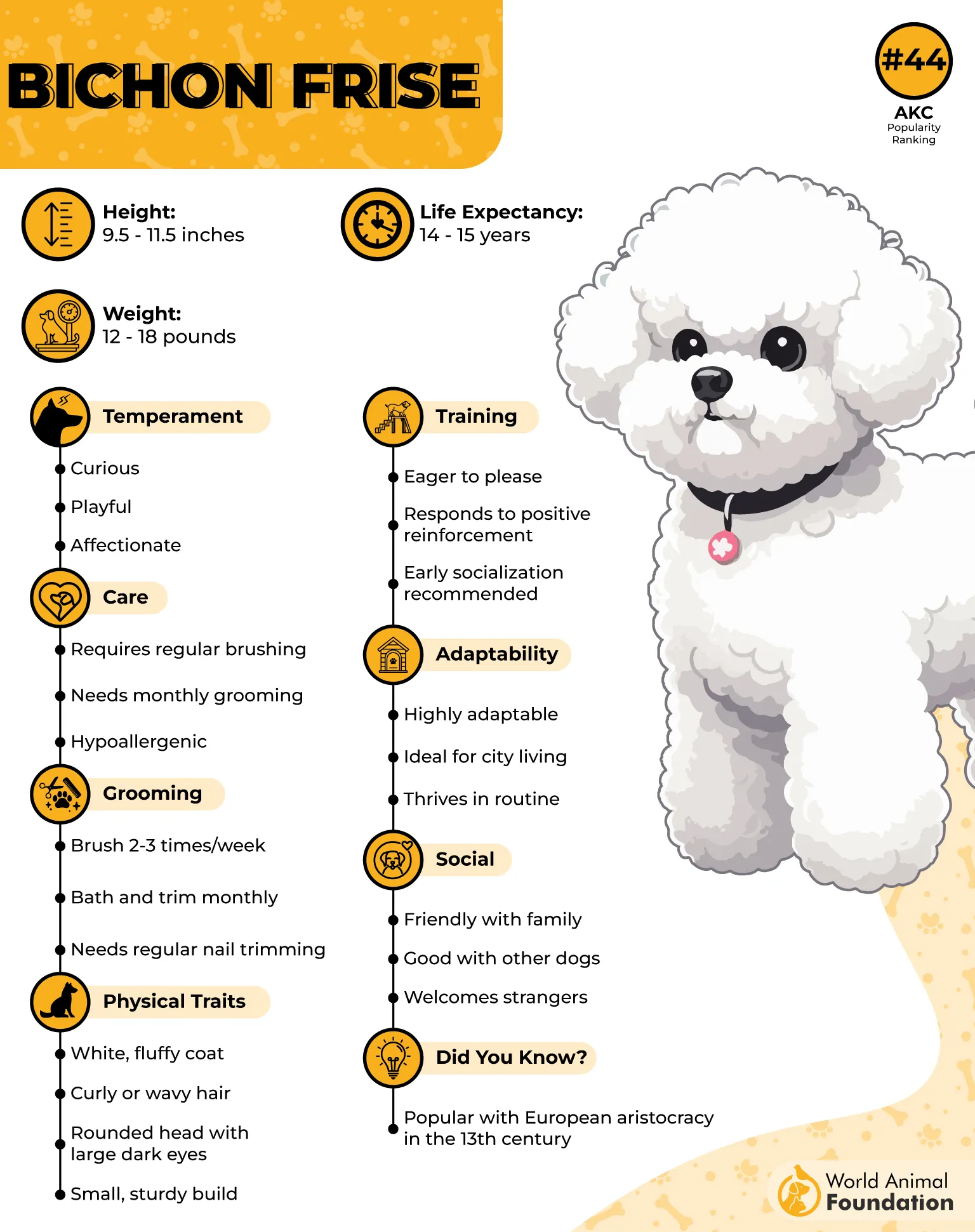
Bathing a Bichon Frise requires a gentle touch. Their fluffy coat tends to trap dirt, so regular baths with a moisturizing dog shampoo are necessary. Proper drying—first with a towel, then a blow dryer on low heat—is crucial to maintain their coat’s fluff and prevent post-bath matting.
Trimming is another vital part of the Bichon’s routine care. Whether kept in a traditional full-coated style or a shorter, easier-to-manage cut, they need professional grooming every 4–6 weeks. Regular trims maintain their adorable shape and prevent the coat from becoming overwhelming.
Beyond their fur, Bichons need routine care for their ears, eyes, and nails. Cleaning their ears helps prevent infections, while wiping around their eyes can reduce tear stains. Keeping nails trimmed protects their posture and comfort. With consistent care, a Bichon Frise stays as healthy, happy, and irresistibly fluffy as nature intended.
4. Portuguese Water Dog
The Portuguese Water Dog is built for adventure, with a rugged, athletic nature and a coat designed for life on the water. However, while their curly or wavy fur is water-resistant and practical, it requires attention to stay healthy and free from mats and tangles that can form after active outdoor days.
Without regular care, their dense curls or waves can trap dirt, debris, and loose hair, leading to painful mats. A thorough brushing two to three times a week not only keeps the coat tidy but also helps distribute natural oils, preserving its signature sheen.
Purina states bathing is another important part of their upkeep. Though their coat repels water, they can still collect dirt, especially after swims or outdoor adventures. Using a mild shampoo designed for active breeds helps maintain the texture of their fur without stripping away essential oils.
One of the more distinctive features of the Portuguese Water Dog is their traditional clips—the “retriever clip” and the “lion clip.” These styles aren’t merely for aesthetics; historically, the lion clip helped improve their swimming ability. Regardless of the chosen clip, professional attention every six to eight weeks is vital to keep their coat at a manageable length and avoid a tangled mess.
Nail trims, dental hygiene, and eye checks complete a maintenance regimen that ensures they remain comfortable and healthy. For the active and affectionate Portuguese Water Dog, consistent care is not just about appearance—it’s about honoring their adventurous nature with the attention they deserve.
5. Puli
Puli are long-haired dogs known for their unique corded, water-resistant coats that resemble mops. These dogs aren’t born with corded coats; instead, their fur gradually develops its signature texture through shedding and tangling over time.
Owning a Puli means embracing a coat like no other—one that commands attention and requires a completely different approach to care. These woolly dynamo dogs don’t need to be brushed like typical fluffy breeds; their cords, which naturally form over time, are a defining part of their identity.
It’s a meticulous process—separating the new cords by hand and untangling any mats before they become problematic. Skip this crucial step, and the cords can fuse into a tangled mass that’s painful for the dog and nearly impossible to untangle later.
As noted by WebMD, bathing a Puli is an event in itself. Their cords absorb water like sponges, holding moisture for hours. A thorough rinse is essential to ensure no soap is left trapped within the layers, as it can lead to skin irritation. Drying requires patience, and sometimes the use of fans to ensure that every cord is fully aired out. Rushing this step can result in mildew or skin infections in the dense coat.
Though daily maintenance doesn’t involve traditional brushing, regular checks are necessary. Dirt, twigs, and even small stones can find their way into the cords unnoticed. A quick manual inspection helps keep their coat free from debris and ensures the cords remain separate and untangled. This type of upkeep feels more like careful attention than typical coat care.
In addition to the coat, routine tasks like trimming nails, cleaning ears, and monitoring skin health are part of Puli’s regular care.
6. Komondor
The Komondor, known for its distinct corded coat, stands out as one of the most unique breeds when it comes to coat care. This high-maintenance dog needs regular attention to keep its cords in good condition and ensure comfort.
Hillspet states Komondor’s heavy cords, resembling dreadlocks or mops, have their appeal but require dedication that goes beyond the basics. If neglected, they can become matted, leading to discomfort and skin irritation for the dog.
Owners must separate the cords regularly to prevent them from fusing together. This meticulous process helps maintain their distinctive look and prevents tangles, dirt, and debris from harming the skin underneath.
Despite their striking appearance, Komondors are active, engaging companions. Their exercise needs are considerable, and maintaining their coat can help reduce shedding, keeping the home cleaner. Although they shed minimally, ongoing care ensures their dense cords remain free of unwanted buildup, promoting both health and comfort.
The cords need frequent checks for tangles, and their dense undercoat can trap moisture, which may lead to skin issues if left unchecked. Professional assistance is often necessary to keep the cords manageable, especially when it comes to trimming and detangling.
For pet owners willing to invest time and effort in their unique grooming needs, Komondors make excellent companions. Their distinctive coat care requirements add to their uniqueness, and with the right attention, they flourish as loving, loyal pets. The effort is rewarded with a happy, healthy dog always ready for an active lifestyle.
7. Yorkshire Terrier
The Yorkshire Terrier, or Yorkie, is a breed with higher grooming requirements due to its long, silky coat. Yorkies need consistent care to keep their coat smooth and free from tangles. Their fine hair is prone to matting, making daily brushing essential to avoid discomfort and irritation.
Daily brushing is necessary to prevent knots and tangles, especially around the ears and legs. This not only keeps the coat manageable but also helps manage shedding, ensuring their coat stays clean and free from loose hairs. Brushing minimizes shedding and promotes overall coat health.
Yorkies also benefit from occasional professional trims every 4-6 weeks to maintain coat length and prevent it from becoming unruly. Trimming around the face and eyes keeps their signature look sharp and free from irritation. These trims ensure that their coat remains well-groomed and easy to manage.
Bathing is another important part of Yorkie care. Occasional baths help keep them clean, but over-bathing can strip the natural oils from their coat. Using a gentle, dog-specific shampoo preserves the softness and shine of their fur without causing dryness.
In addition to coat care, regular ear cleaning and nail trimming are necessary for Yorkies. Their small ears can accumulate wax, so routine inspection is important to prevent infections.
With the right grooming routine, Yorkshire Terriers make wonderful companions. At the same time, they require more care than some low-maintenance dogs; their affectionate and playful nature makes the effort well worth it.
8. Shih Tzu
The Shih Tzu’s flowing coat may appear effortless, but it requires a daily commitment that few breeds can rival. Their long, silky hair tangles easily, making frequent brushing essential. Without daily attention, mats can form quickly, affecting both their appearance and the health of their sensitive skin beneath.
Brushing a Shih Tzu goes beyond mere aesthetics—it’s vital for their well-being. Using a gentle pin brush, owners must work through the thick layers to prevent painful knots and maintain a soft, healthy coat. Daily brushing also helps distribute natural oils, giving their fur its signature shine and turning grooming into a rewarding bonding experience between dog and owner.
Even with a dedicated home care routine, professional grooming plays an important role. Regular visits to a groomer help maintain coat structure, manage overgrowth, and detect any hidden issues early on. Groomers can also provide tips tailored to the dog’s specific needs, simplifying at-home upkeep.
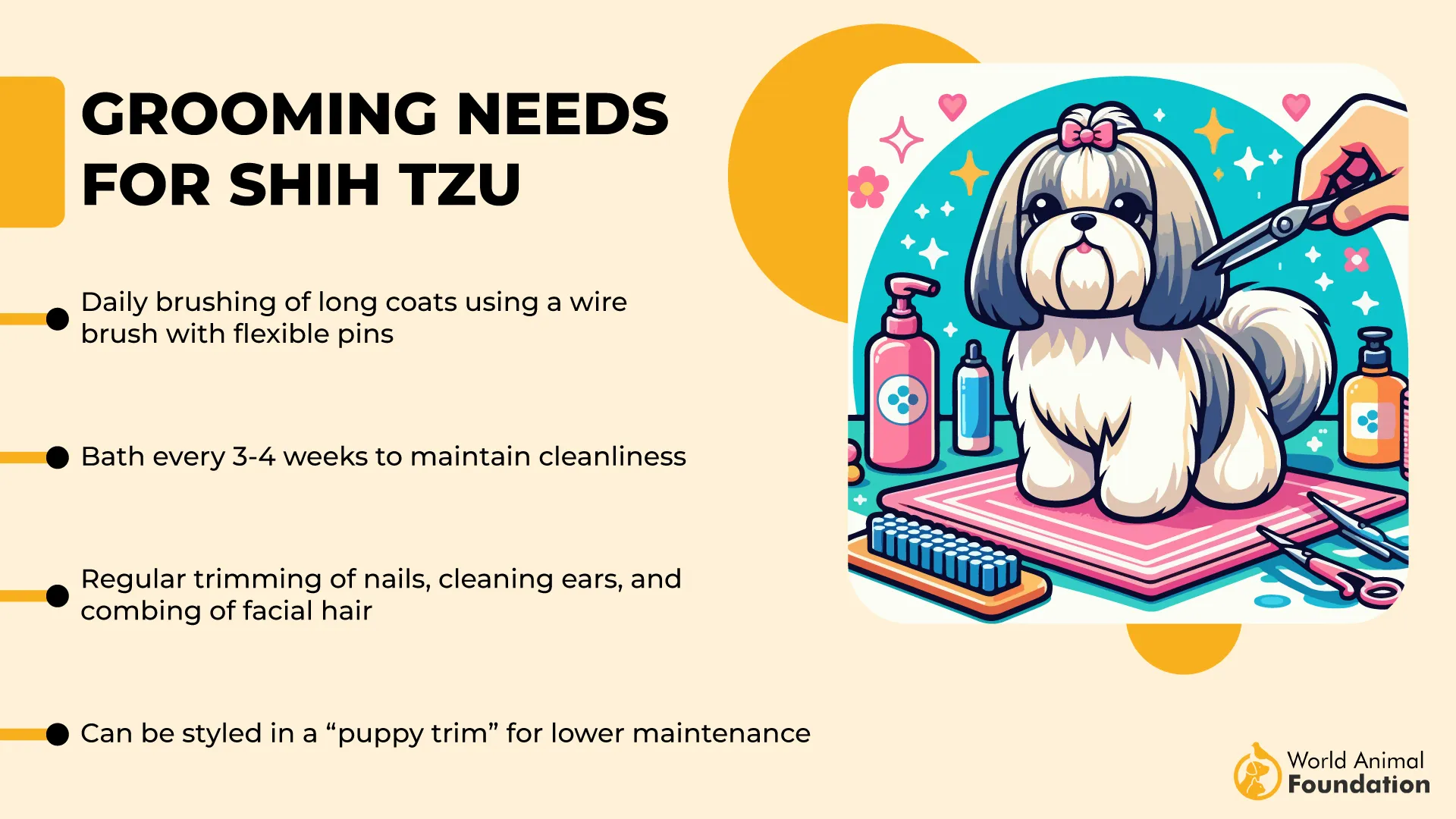
Long-coated Shih Tzus require extra attention, including bathing, drying, conditioning, and thorough combing to keep their hair clean and comfortable. For owners seeking a lower-maintenance option, a “puppy cut” offers a practical alternative, though it still requires regular brushing to preserve coat health.
Grooming a Shih Tzu is more than just keeping them looking good—it’s an ongoing commitment to their comfort and happiness. With consistent care and expert advice, owners can ensure their little companions remain radiant and feel their best.
9. Maltese
The Maltese, with its exquisite silky coat and charming appearance, requires consistent grooming to maintain its beauty. Their long, flowing hair can quickly become tangled without regular care, making grooming a non-negotiable task for owners. For a well-maintained coat, daily brushing is recommended to keep it smooth and free from mats.
Brushing is the cornerstone of the Maltese grooming routine. Their silky coats can easily mat if left unchecked, so regular brushing with a gentle pin brush is essential. It’s a simple but vital task that prevents tangles and helps keep the coat shiny while also promoting skin health by stimulating natural oils.
While home grooming is important, Maltese dogs benefit from professional grooming sessions. Regular trims not only help manage their hair’s length but also maintain its optimal condition. A professional groomer ensures the coat is neat and free of knots and provides additional tips for maintaining the dog’s skin and hair between visits.
Maltese coats require more than just occasional brushing—they need regular care to stay healthy and comfortable. Without attention, their long hair can lead to skin irritation and matting, so it’s essential to stay on top of their grooming needs.
Regular baths and trims help keep their silky coats manageable and prevent issues like dryness or buildup of dirt.
Despite their grooming needs, the Maltese make an ideal companion for those willing to invest the time. Their adorable appearance and affectionate nature make them great companions. With proper grooming, they remain healthy and happy. The effort put into caring for their coat is more than rewarded by their loving personality and loyalty.
10. Lhasa Apso
The Lhasa Apso’s long, flowing coat requires extensive grooming. Beneath the elegant hair lies a thick undercoat that needs regular care. Without attention, mats can form quickly, causing discomfort and skin issues. For owners, maintaining their coats is essential.
Weekly brushing is the minimum needed to prevent tangles. Ideally, the coat should be brushed several times a week with a pin brush to keep it smooth and manageable. Skipping brushing can lead to painful knots and complicate the grooming process.
Professional care is key for maintaining a Lhasa Apso’s coat. Regular grooming sessions help manage the thick coat, keeping it clean and free from mats. Groomers can also provide helpful grooming tips for easier at-home upkeep.
For a more manageable routine, trimming the coat to a shorter style can reduce tangling and simplify maintenance. A haircut ensures easier upkeep without sacrificing the dog’s signature look.
Owning a Lhasa Apso means committing to grooming as part of their care. With regular brushing, professional assistance, and thoughtful grooming, their coat remains clean, healthy, and beautiful.
Conclusion
Grooming requirements vary widely among dog breeds. Long-haired breeds like the Golden Retriever or Cocker Spaniel need regular care to maintain a healthy coat, while dogs with wiry coats, such as Schnauzers, require attention to prevent mats and manage shedding. Low-maintenance dogs, like French Bulldogs, need only basic grooming to keep their coat clean.
Regardless of coat type, regular grooming is essential to ensure all dogs remain comfortable and healthy. With the right care, whether it’s brushing, trimming, or general upkeep, dogs of all breeds can enjoy a clean, well-maintained coat and a happy life.


